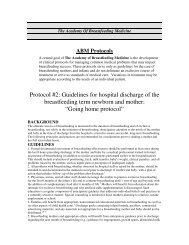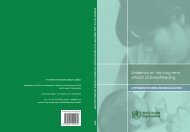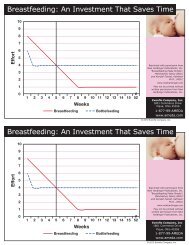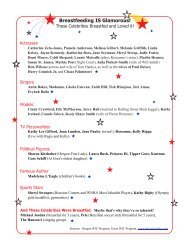Congenital Tongue-Tie and Its Impact on Breastfeeding - New ...
Congenital Tongue-Tie and Its Impact on Breastfeeding - New ...
Congenital Tongue-Tie and Its Impact on Breastfeeding - New ...
You also want an ePaper? Increase the reach of your titles
YUMPU automatically turns print PDFs into web optimized ePapers that Google loves.
Page 4<strong>Breastfeeding</strong>: Best for Baby <str<strong>on</strong>g>and</str<strong>on</strong>g> MotherCONGENTIAL TONGUE-TIE [CONTINUED FROM P 3]However, the author suggests infant acetominophendrops 10mg/kg q4h for 24hours as needed. A drop of topical benzocaine<strong>on</strong> the clean small finger, may be usedif the frenotomy site seems sore during thefirst 24 hours. It can be placed under thet<strong>on</strong>gue where the snip was performed.Fortunately, complicati<strong>on</strong>s are minimal.Only rarely is a general anesthetic needed,when a frenuloplasty (transverse cutting<str<strong>on</strong>g>and</str<strong>on</strong>g> vertical repair) is needed rather than asimple anterior to posterior snip(frenotomy). 15Medical management of t<strong>on</strong>gue-tiesurgical interventi<strong>on</strong> may not be an opti<strong>on</strong>because of religious, cultural, or pers<strong>on</strong>alreas<strong>on</strong>s or because the parents are unableto find a medical professi<strong>on</strong>al willing toprovide surgical treatment. In these casesthe lactati<strong>on</strong> c<strong>on</strong>sultant usually plays a criticalrole. Multiple latch modificati<strong>on</strong>s maybe employed to find <strong>on</strong>e that is adequate.Mothers may need to express milk to helpmaintain an adequate milk supply <str<strong>on</strong>g>and</str<strong>on</strong>g> optimalinfant growth. As the child grows <str<strong>on</strong>g>and</str<strong>on</strong>g>the mother perseveres, successful breastfeedingmay be possible, though some degreeof discomfort may c<strong>on</strong>tinue. C<strong>on</strong>tinuedbreastfeeding in this situati<strong>on</strong> typicallyrequires much time, patience, emoti<strong>on</strong>al<str<strong>on</strong>g>and</str<strong>on</strong>g> professi<strong>on</strong>al support, <str<strong>on</strong>g>and</str<strong>on</strong>g> a dedicatedmother.Other Oral FrenulaIn additi<strong>on</strong> to the lingual frenulum, thereare several other oral frenula (Genna,Weissinger): a buccal frenulum c<strong>on</strong>nectscheek to gum; a labial frenulum c<strong>on</strong>nectsthe upper or lower lip to the gum, especiallythe superior labial frenulum whichruns from the center of the upper lip tothe gum line. These may interfere with lip“flanging”.A baby who cannot flange his /her upper lipbecause of a tight upper labial frenulummay need to alter his/her nursing positi<strong>on</strong>or have it surgically released in order topermit effective nursing. A mother with ashort nipple <str<strong>on</strong>g>and</str<strong>on</strong>g> inelastic breast tissue mayhave trouble even achieving latch-<strong>on</strong> withsuch a baby. It may be that a short or tightlower labial frenulum can cause similar problemsby preventing the lower lip from flanging.C<strong>on</strong>clusi<strong>on</strong><str<strong>on</strong>g>T<strong>on</strong>gue</str<strong>on</strong>g>-tie is a significant clinical entity,which, when symptomatic, should be treatedas early as possible to minimize this breastfeedingproblem. Surgical treatment is safe<str<strong>on</strong>g>and</str<strong>on</strong>g> effective. Complicati<strong>on</strong>s are rare <str<strong>on</strong>g>and</str<strong>on</strong>g>general anesthesia is not required.About the AuthorDr Coryllos is a pediatric surge<strong>on</strong>, <str<strong>on</strong>g>and</str<strong>on</strong>g> isemeritus director of pediatric surgery atWinthrop University Medical Center, ateaching hospital in <strong>New</strong> York. She has performedover 500 frenotomies since 1953,<str<strong>on</strong>g>and</str<strong>on</strong>g> has found the results to be satisfactoryin all cases, <str<strong>on</strong>g>and</str<strong>on</strong>g> excellent in most, with fewcomplicati<strong>on</strong>s.[c<strong>on</strong>tinued <strong>on</strong> p 5]BOX BTEST-WEIGHINGTest-weighing is defined as “weighing theinfant before <str<strong>on</strong>g>and</str<strong>on</strong>g> after breastfeeding todetermine intake.”Test-weighing requires an appropriatedigital scale with the following features1. Digital read-out2. Integrati<strong>on</strong> functi<strong>on</strong> that allows formovement of the infant3. Accurate to 2 gramsTest-Weighing Procedure:1. Before breastfeeding, place baby <strong>on</strong> thescale <str<strong>on</strong>g>and</str<strong>on</strong>g> weigh him. No need to undressthe baby. This is the "before" weight.2. Mother breastfeeds the infant. DONOT CHANGE DIAPER YET.3. Reweigh the infant, WITH THE EXACTSAME CLOTHES, DIAPER, BLANKET,etc). This is the "after" weight.4. Subtract the first (before) weight fromthe sec<strong>on</strong>d (after) weight. The differencein grams is c<strong>on</strong>sidered the "intake" inmilliliters.5. Some scales automatically store thevalues <str<strong>on</strong>g>and</str<strong>on</strong>g> compute the difference foryou. Refer to manufacturers instructi<strong>on</strong>s.Untreated t<strong>on</strong>gue-tie in an 11 year old child.Mis-shapen palate <str<strong>on</strong>g>and</str<strong>on</strong>g> dental ridgein the same childReferences:1. Ardran G, Kemp F, Lind J. A Cineradiographicstudy of breastfeeding. Br Jof Radiol. 1958;31(363):156-1622. Ardran G, Kemp F. Some importantfactors in the assessment of oropharyngealfuncti<strong>on</strong>. Dev Med Child Neurol.1970;12:158-1663. Ballard, JL et al. Ankyloglossia: assessment,incidence, <str<strong>on</strong>g>and</str<strong>on</strong>g> dffect of frenuloplasty<strong>on</strong> the breastfeeding dyad.Pediatrics. 2002;110(5):e63-e684. Bosma J, Hepburn L, Josell S, et al.Ultrasound dem<strong>on</strong>strati<strong>on</strong> of t<strong>on</strong>guemoti<strong>on</strong>s during suckle feeding. DevMed Child Neurol. 1990;32:223-2295. Bullock F, Woolridge M, Baum, J.Development of coordinati<strong>on</strong> of sucking,swallowing <str<strong>on</strong>g>and</str<strong>on</strong>g> breathing: ultrasoundstudy of term <str<strong>on</strong>g>and</str<strong>on</strong>g> preterm infants.Dev Med Child Neurol.1990;32:669-678[C<strong>on</strong>tinued <strong>on</strong> p 6]








